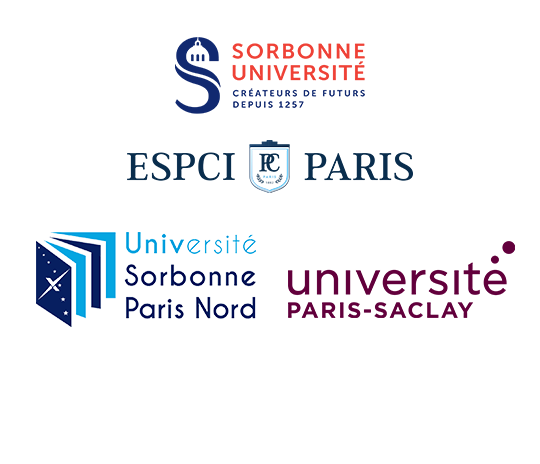The Subject
The aim of the thesis is the study of interactions between metal nanoparticles at atomic scales
using Monte Carlo and molecular dynamics. The knowledge obtained by this approach will be
used to better explain the assembly of nanoparticles experimentally observed. The study of
assemblies made from nanoparticles is one of the most studied research areas nowadays.
Many applications in industry are expected for these systems. Our approach requires both the
use of modern programming techniques and effective methods of simulation. This study will
be carried out in close collaboration with experimentalists in the laboratory.The hosting laboratory
-The thesis will be in the Laboratoire des Matériaux Mesoscopiques et Nanométriques
(LM2N) at the University P. et M. Curie in the center of Paris.
The Laboratory of mesoscopic and nanoscale materials is directed by Professor Christophe
Petit. It consists of 2 professors, 1 director of research, 5 lecturers, 2 engineers, 2 technicians,
3 postdocs and 3 PhD students.
The laboratory is internationally recognized for his work in nanoscience.
It was classified as laboratory A + (best rank) by the AERES (Official French agency to
evaluate the research). The University Pierre et Marie Curie is ranked 39th Unversity in the
Academic Ranking of World Universities. The members of the laboratory are
experimentalists and theoreticians that allows a strong collaboration between theory and
experiment. The student will have at his disposal several multi-processor computers to
perform simulations. More information can be found on the site www.sri.jussieu.fr
–The candidate
-We seek a candidate who has a background in chemistry or physics. Prior knowledge of
simulation techniques, such as Monte Carlo simulations would be an advantage. He or she
must also have knowledge in programming. The candidate will change and test the simulation
code and make himself the simulations.
–Details on the project
-State of the art
Ten years ago, Luedtke and Landmann 1-3] have used molecular dynamics to study gold nanocrystals
surrounded by thiols at atomic scales. Thus, they explained the structures that form between the thiols
of two nanocrystals. They also made calculations to predict the transition between the assemblies of
nanocrystals in fcc and bcc lattices [3]. In their approach, they neglect the solvent. However, recent
experiments have shown that the interactions due to solvent are critical to understand nanocrystal
assembly [4].
Only two years ago the first simulations of interaction between two nanocrystals including explicit
solvent were carried out [5-7]. Especially the work of Schapotschnikow et al. [5] is a real
breakthrough in this direction. They predict a pure repulsion between the gold nanocrystals in hexane.
These calculations are limited to particle sizes of 3 nm. However, nanocrystal assembly in solution
takes place for particle sizes of 5 nm and more and in other solvents than hexane such as toluene. For
this reason, we want to push the limits of the simulations at sizes above 5 nm using other solvents.
–Research program
-First, a single gold nanocrystal with and without the solvent hexane is considered. Meanwhile, Monte
Carlo and molecular dynamics will be developed, allowing independent control, since both methods
should give the same results. A code for these calculations was recently written that allows the PhD
student to have the first results quickly.
Then, the solvent is replaced by toluene. This study will show the differences in interactions between
the thiol and the two solvents.
In a third step, we will study the interaction between two nanocrystals in hexane or toluene. Thus, we
may interpret the experience on nanocrystal assembly performed in parallel in our laboratory. The
results can be directly compared with predictions of the theory of Flory.
In the following, the simulation code can be applied to answer many other questions that arise in the
context of assemblies of nanoparticles.
For example, the interaction between a nanocrystal and the air-liquid interface can be simulated using
the new software. On the other hand, the fact that the nanocrystals may form different supercrystalline
structures, such as fcc, hcp or bcc, is still poorly understood. In this framework, the code will be able
to simulate the interaction between nanocrystals in fcc, hcp and bcc supercrystals and thus explain the
experimental results.
Literature:
-(1) W. D. Luedtke and U. Landman, Structure, Dynamics, and Thermodynamics of Passivated Gold
Nanocrystallites and Their Assemblies, J. Phys. Chem., 1996, 100, 13323–13329
-(2) W. D. Luedtke and U. Landman, Structure and Thermodynamics of Self-Assembled Monolayers
on Gold Nanocrystallites, J. Phys. Chem. B, 1998, 102, 6566–6572
-(3) U. Landman W. D. Luedtke, Small is different: energetic, structural, thermal, and mechanical
properties of passivated nanocluster assemblies Faraday Discuss.,2004, 125,
-(4) J. Richardi, A.T. Ngo, M. P. Pileni, “Simulations of cracks supported by experiments: The
influence of the film height and isotropy on the geometry of crack patterns”, J. Phys. Chem C, 114,
17324 (2010).
-(5) Schapotschnikow, P.; Pool, R.; Vlugt, T. J. H., Molecular simulations of interacting nanocrystals,
Nano Lett. 2008, 8 (9), 2930-2934.
-(6) J. M. D. Lane, A. E. Ismail, M. Chandross, C. D. Lorenz, and G. S. Grest, Forces between
functionalized silica nanoparticles in solution, Phys. Rev. E 79, 050501 (2009).
-(7) J. M. D. Lane and G. S. Grest, Spontaneous Asymmetry of Coated Spherical Nanoparticles in
Solution and at Liquid-Vapor Interfaces, Phys. Rev. Lett. 104, 235501 (2010).
-*Contact: [RICHARDI Johannes until 01/05/2011

